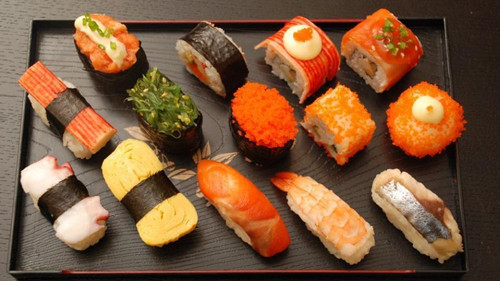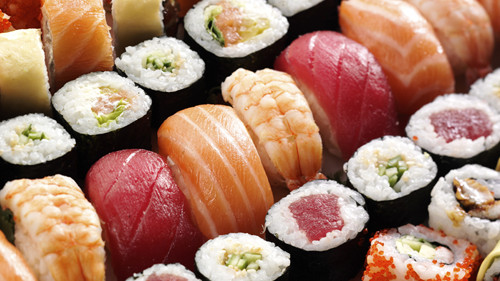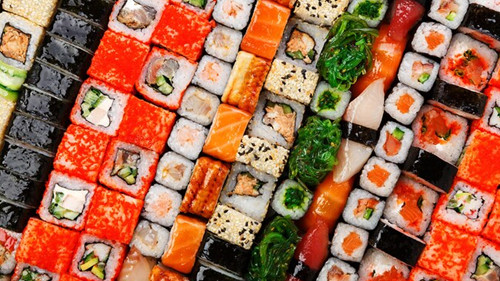How to Cut Sushi
How to Cut Sushi – Sushi Cutter Machine – Cheersonic
Sushi —— A Traditional Japanese Dish

Brief Introduction
Sushi is a traditional Japanese dish of prepared vinegared rice, usually with some sugar and salt, accompanying a variety of ingredients, such as seafood, often raw, and vegetables. Styles of sushi and its presentation vary widely, but the one key ingredient is “sushi rice”. Sometimes it is confused with sashimi, a related dish in Japanese cuisine that consists of thinly sliced raw fish, or occasionally meat, and an optional serving of rice.
History
Sushi originates in a Southeast Asian dish, known as narezushi, stored in fermented rice for possibly months at a time. The lacto-fermentation of the rice prevents the fish from spoiling; the rice would be discarded before consumption of the fish. This early type of sushi became an important source of protein for its Japanese consumers.
Vinegar began to be added to the preparation of narezushi in the Muromachi period (1336–1573) for the sake of enhancing both taste and preservation. In this stage, the sushi is prepared by pressing seafood and rice into shape with wooden (typically bamboo) molds.
It was not until the Edo period (1603–1868) that fresh fish was served over vinegared rice and nori. The particular style of today’s nigirizushi became popular in Edo (contemporary Tokyo) in the 1820s or 1830s. The dish was originally termed Edomae zushi as it used freshly caught fish from the Edo-mae (Edo or Tokyo Bay); the term Edomae nigirizushi is still used today as a by-word for quality sushi, regardless of its ingredients’ origins.

Different Types
The common ingredient in all types of sushi is vinegared sushi rice. Fillings, toppings, condiments, and preparation vary widely. Common types of Sushi are as following:
- Makizushi
Makizushi is a cylindrical piece, formed with the help of a bamboo mat known as a makisu. It is generally wrapped in nori (seaweed), but is occasionally wrapped in a thin omelette, soy paper, cucumber, or shiso (perilla) leaves. Makizushi is usually cut into six or eight pieces, which constitutes a single roll order.
- Inarizushi
Inarizushi is a pouch of fried tofu typically filled with sushi rice alone. Cone sushi is a variant of inarizushi originating in Hawaii that may include green beans, carrots, or gobo along with rice, wrapped in a triangular abura-age piece.
- Nigirizushi
Nigirizushi (“hand-pressed sushi”) consists of an oblong mound of sushi rice that the chef presses between the palms of the hands to form an oval-shaped ball, and a topping (the neta) draped over the ball. It is usually served with a bit of wasabi; toppings are typically fish such as salmon, tuna or other seafood. Certain toppings are typically bound to the rice with a thin strip of nori, most commonly octopus (tako), freshwater eel (unagi), sea eel (anago), squid (ika), and sweet egg (tamago).
Homemade / making steps
In daily life, we could make Sushi rolls at home by ourselves. We need ingredients and tools as below:
Ingredients:
Cooked shrimp (prawns)
Crab (or surimi)
Eggs (made into an omelet and cut into strips)
Cucumber (cut into strips)
Carrot (cut into strips)
Tools:
bamboo sushi roller
sushi vinegar
roasted seaweed
sushi rice
Making Steps:
Setp1: place the rice and the cold water in a medium saucepan and bring to the boil. put the boiled rice into a large bowl and make it cold or turn the heat down to very low.
Step2: add two or three teaspoon sushi vinegar into the boiled and cold rice in a large bowl, mix together gently and evenly to coat the rice with the sushi vinegar.
Step3: flatten the roasted seaweed on the bamboo sushi roller, then put evenly the sushi rice (see secondly) into the roasted seadweed and arrange equal amounts of each filling,like cooked shrimp, crab,cucumber, carrot, egg on top. lastly, Roll the sushi up and cut into 1½-inch rounds to serve.

Sushi rolls are often cut into small pieces. For small production volume, it could be cut by hand with normal cutter. But in Sushi production lines, it is always cut by automatic cutter. However, are ever imaging that it is even could be cut by ultrasonic technology!
Ultrasonic power would help Sushi be cut more fastly and smoothly. Because of high frequency on the connected blade, the cutter would not be sticky. And with the adjustable cutting speed, ultrasonic cutter could offer a more flexible and perfect cutting effect.
Cheersonic makes automated cutting solutions for most kinds of baked food according to customers’ demand. Ultrasonic cutting technology is advanced. We quickly adjust the size of the machine blades, and quickly cut the Sushi into slices with the specified size and shapes you want it to be. The most important benefit is ultrasonic High-quality aesthetics brought by cutting.
Try different types of Sushi! Try ultrasonic cutter for Sushi rolls!
